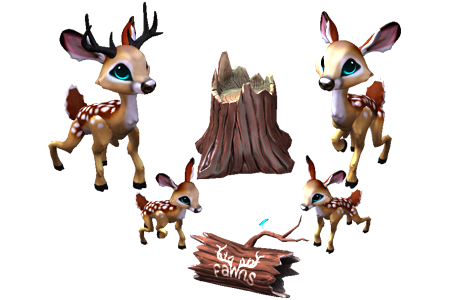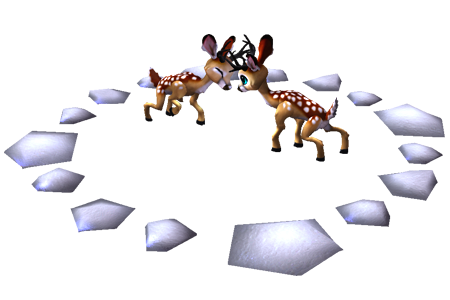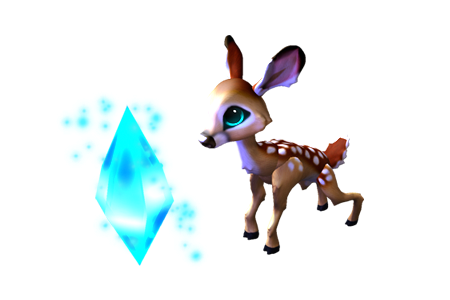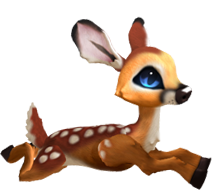The History of Fawns
Hidden deep within the most secluded forests of the world, a new light has begun to grow brighter. They were once thought to be little more than a myth. Legends and stories told to young children just before bed. Now, we know better.
Commonly referred to as 'Fawns', these creatures have been living in secret for generations. Hidden from sight, bits and pieces of their history are starting to accumulate. We once thought them as messengers from the Gods, escorts to the afterlife, and guardians of humanity.
Even in our modern day, we still think highly of them. We portray them in our books and movies as supernatural entities. We continue to pass down the tales given to us by our ancestors. Who knew this folklore was much closer to being fact rather than fiction?

|
Breeding in Captivity
All around the globe, animal lovers have taken a keen interest in Fawns. Humanity wants to preserve the creature's populace, to keep their race alive and well. We also want to benefit monetarily and, of course, to have a new pet to add to the household. After all, who could resist having a friendly little Fawn in their life?
It's these reasons and many more that power our desire to breed them in captivity. We want to learn from the Fawns - to gain a better understanding of their lifestyle, their culture, and their needs. Knowledge is a craving that human kind cannot resist and, as is often the case, we have managed to figure out how to gain from this in more ways than one.
There are hundreds, perhaps even thousands, of breeders. In every corner of the Earth, cropping up faster and faster each day, actively trying to breed through the genome in an attempt to find newer and more rare Fawns.
Every so often, a new pattern will show up. A new trait. A new personality. This only furthers the reasoning behind breeding, adding one more step to the journey.
|
Racing on the Track
Have you ever seen a Fawn in the real world? No? Well, don't worry. Most haven't. They're quick creatures who don't often stand still long enough to be spotted. It's the basis of a very common misconception in the Fawn community.
You see, they don't hide as often as we once believed them too. Rather, Fawns love to run. They tend to be very competitive, as well. While some Fawns turn to fighting, many of them have found a much more civilized way of sportsmanship.
Even in the wild, Fawns have been found to line up and race each other to various points of interest. This is why humans have been so intent on constructing race tracks for Fawns to use in competition. Now, we have them.
With no human intervention, the Fawns are left in control of the entire event. It really is a freeing experience - both for those taking part in the race and for the humans watching as they gracefully prance down the track.
|

|

|
Dueling in the Arena
An act predominantly done by males with far too much testosterone, Fawns can occasionally be seen slamming their antlers together. The sound of bones click-clacking against each other can be heard for miles around.
Every so often, one can catch sight of a male Fawn rolling beneath their opponent in an attempt to trip them up. This gives the Fawn a clear advantage. That being said, most Fawns consider this to be too much effort and tend to take a more direct approach - a well placed hoof to the fur, which will usually get their point across just fine.
To some humans, it can seem a little cruel. It's a natural thing though. The bidding of Mother Nature, which cannot be seen as good or bad, cannot be argued with, and simply is. Fortunately, many Fawns turn to racing instead of dueling as an outlet for their stress, energy, and competitive nature.
|
Ether in the Air
Humanity has been researching the theory of Ether for centuries, though this isn't a fact recognized by most. In fact, many have never heard of this strange energy, which is thought to be all around in the Earth's atmosphere. An eternal energy, it could potentially lead human kind to a renewable energy source with little to no ill side effects on the planet.
To date, Fawns are the only known life form able to successfully extract Ether out of the air. Those who are especially skilled can even do this through a sort of crystallized container. Up until now, most crystals have been thought to be mere objects to gaze upon - reflecting and refracting light, with uses and sentimental values only to humans.
In a recent discovery, humanity has witnessed various Fawns behaving in a different manner after exposure to crystals. Further research has proven that these Fawns are pulling energy from external sources - namely, Ether. The information provided here is boundless and countless scientists have begun further research on the matter.
Even more interesting is the proposed theory that this is related to the fact that no Fawn has ever been witnessed consuming food, water, or any physical matter.
|

|
|
|



